We Tested 10 Espresso Knock Boxes—Five Impressed Us
Dotdash Meredith and Yahoo Inc. may earn commission or revenue on some items through the links below.
Our top pick is the homeffect Knock Box.
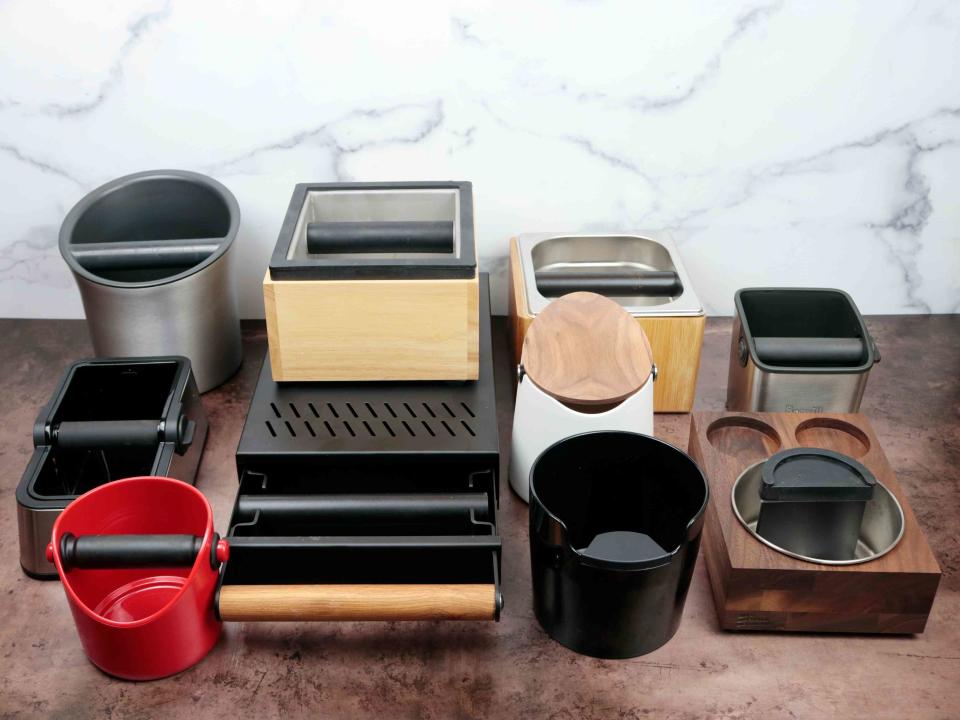
Serious Eats / Jesse Raub
Our favorite espresso knock box was the homeffect Knock Box due to its innovative knock pad and shock absorption. We also really liked the counter-appeal of Crema Coffee Products’ The Arc, the compactness of the Dreamfarm Grindenstèin, and the heavy-duty nature of the Rattleware Bumper Knock Box.
A knock box isn’t integral for making good espresso at home, but it keeps things efficient and tidier. Centered around a rubber-coated bar or pad, it's designed for knocking spent espresso pucks into a catchbin, resetting your portafilter basket for your next shot. It can be a huge timesaver if you make a lot of espresso at home.
Of course, espresso grounds are the bane of tidy counters everywhere, but so are drips from portafilter spouts. A great knock box catches it all and looks cute to boot. There are tons of different styles available, so we picked out 10 notable knock boxes to find which ones performed the best while looking nice and keeping your home coffee bar spotless.
The Winners, at a Glance
homeffect Knock Box
The Best Espresso Knock Box
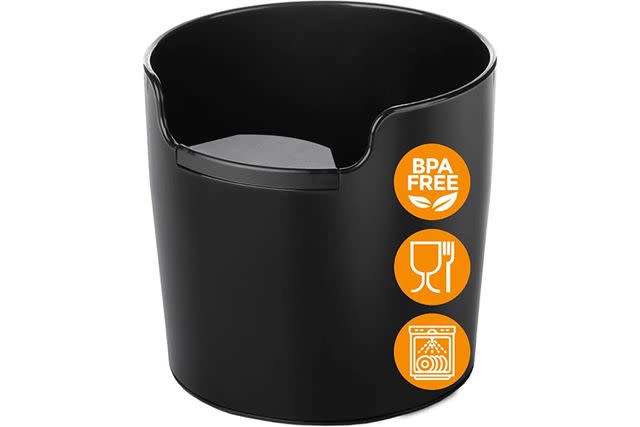
Though it may be simple to look at, the homeffect knock box has a unique knock-pad atop a column in place of a horizontal bar, giving it sturdy knockability in a lightweight package that was super easy to clean.
Crema Coffee Products The Arc
The Best-Looking Espresso Knock Box

With a swooping, tapered body and a walnut lid, The Arc was a welcome, stylish addition to our countertops. It also featured a removable knock bar for easy cleaning and a rubber base for shock-absorption.
Dreamfarm Grindenstèin
The Best Compact Espresso Knock Box
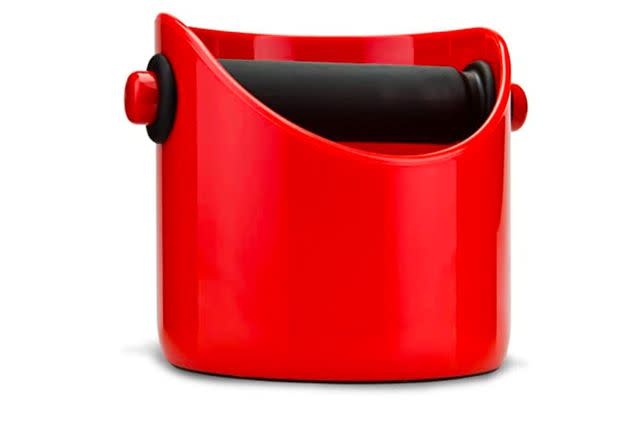
Dreamfarm’s Grindenstèin has been a home espresso standby since it was launched in 2003. Its compact design and thick rubber bar are great at absorbing the shock of a solid puck-knock, and it’s small enough to fit on most espresso machine’s drip trays when not in use.
Rattleware Bumper Knock Box
The Best Heavy-Duty Espresso Knock Box

Rattleware’s Bumper Knock Box has a commercial quality design used in coffee bars everywhere. It features an offset knock bar for cleaner knocks, a heavy-duty catchbin for durability, a rubber bumper that surrounds the catchbin for added shock absorption, and an attractive maple outer box.
Dibsta Knock Box Drawer
The Best Espresso Knock Box, If You Have The Space

Designed to sit underneath your espresso grinder, this drawer-style knock box also has cutouts on the top for easy sweeping loose grounds into the catchbin. We really loved its usability, though it’s quite big: it was too tall to fit under kitchen cabinets with a grinder on top.
The Tests
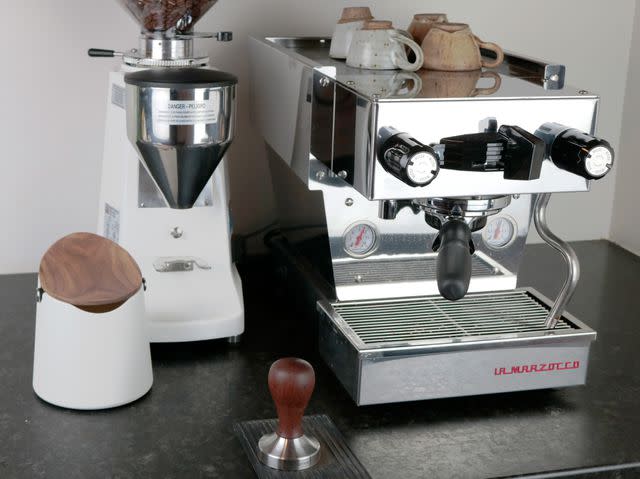
Serious Eats / Jesse Raub
Standard Puck Knock Test: We pulled multiple shots of espresso and knocked the spent puck out into each knock box, noting how easily the puck released, how sturdy and comfortable each knock box was to knock against, and how the design of each knock box affected its performance.
Baked-In Puck Knock Test: We pulled an espresso shot, let it dry out in the portafilter for ten minutes, and then knocked the spent put out into each knock box with an extra hard whack. We noted how easily the puck released, how sturdy the knock box felt with harder knocks, and how the design of each knock box affected its performance.
Usability and Clean Up Tests: We put each knock box into regular use and evaluated how different design elements affected their ease of use and their ability to keep counters clean, and how easy it was to clean each knock box once they were filled with coffee grounds.
What We Learned
Off-Center Bars Made Knocks Simpler
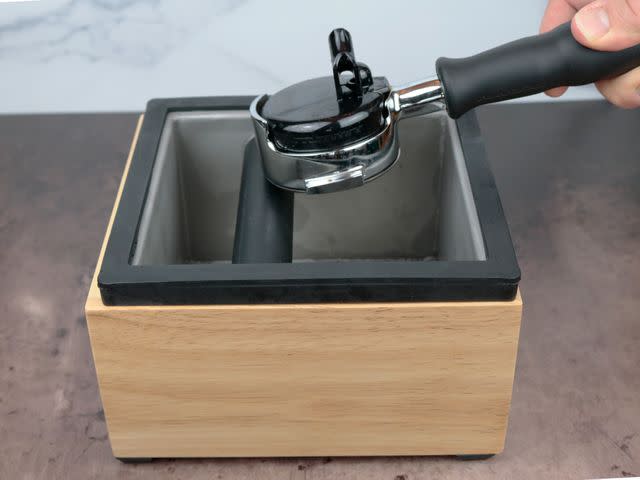
Serious Eats / Jesse Raub
The best knock boxes had an off-center knock bar or knock pad to encourage the espresso pucks to fall directly in the bin. Knocking against a centered bar meant the puck would sometimes split, creating more of a mess in the catchbin. The knock bar on the Rattleware Bumper Knock Box is set around two-thirds of the way across the bin, making it easy to catch just the tip of the portafilter on the bar and letting the puck fall straight down.
The knock pad on the homeffect Knock Box extends out from the front edge of the knock box, letting you easily tap just the back edge of the portafilter on the pad to eject your pucks forward. This made it easy to pop out pucks while catching any stray grounds or drips from the portafilter and keeping pucks intact for easier cleaning later.
Thick Padding Added a Lot of Comfort and Stability
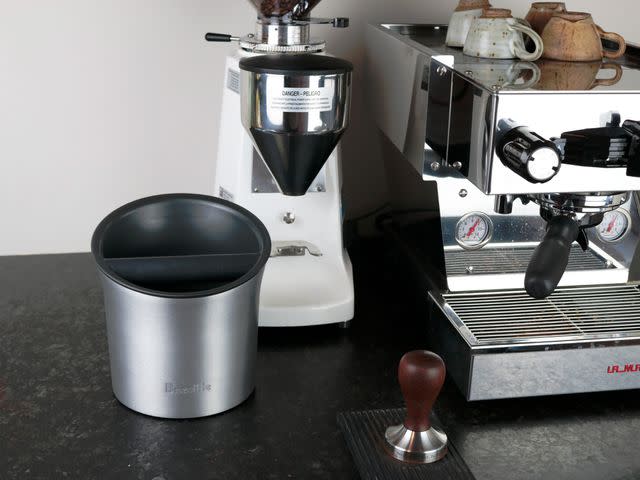
Serious Eats / Jesse Raub
Despite its large size, the Breville knock box had very little rubber padding.The thicker the rubber coating on the knock surface, the more comfortable it was to knock. We really loved how bouncy the bar on the Dreamfarm Grindenstèin and Dibsta Knock Box Drawer were, but both models from Breville were lacking. With just a thin rubber coating, the knocks on the Breville Knock Box and Breville Knock Box Mini sent a lot of vibrations back to the wrist, which was unsettling. The boxes also hopped on the counter with each knock.
Wider Openings Kept Counters Cleaner
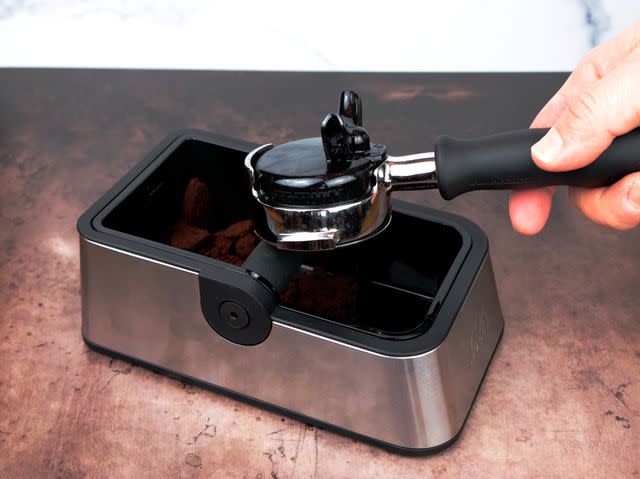
Serious Eats / Jesse Raub
Narrow knock boxes made it harder to aim.Narrow knock boxes, like the Solis Perfetta Knock Box, made a well-placed knock difficult, and also didn’t catch errant drips or loose grounds as well. Wider openings, like on the Rattleware or the larger Breville models, made it easier to aim and kept counters cleaner.
Read More:We Tested 14 Espresso Machines to Find the Best Ones, Depending on Your Needs
We also liked circular knock boxes, like the homeffect, Dreamfarm, and Crema models. By mirroring the shape of the portafilter basket, the round boxes provided extra space around the entire circumference of the basket for better clean up.
Some Designs Were Unexpectedly Sturdy
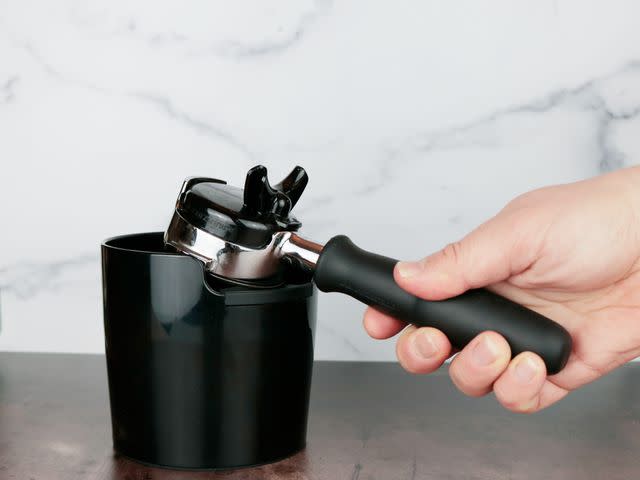
Serious Eats / Jesse Raub
With a support column that goes all the way to the base, the homeffect knock box was surprisingly sturdy for how lightweight it was.While a thick rubber padding added to shock absorption, so did rubber feet and overall design. Surprisingly, the lightweight plastic homeffect knock box had the best shock absorption due to its rubber-coated knock pad and column. By situating the rubber pad on top of a vertical column instead of a horizontal bar, the entire impact is absorbed in the base. Even with more than 16 years of professional coffee experience, we’d never seen a design like this before.
We wish we could say the same great things about the Saint Anthony Industries’ The Bloc, which also featured a knock pad, but the stainless steel bin it was attached to was flimsy and buckled under pressure, causing the knock box to wobble.
Deeper Bins Were More Efficient
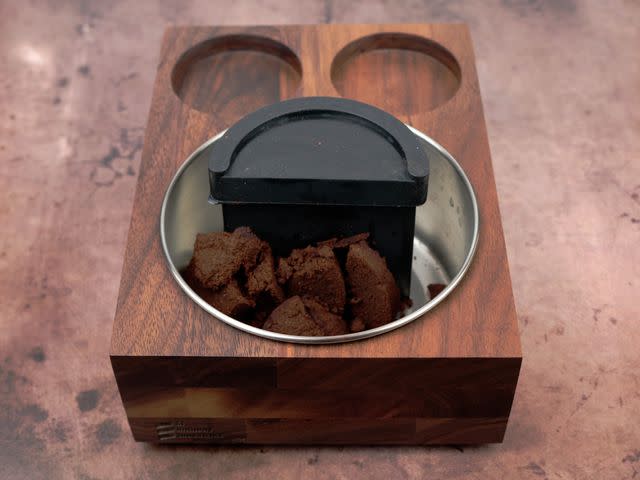
Serious Eats / Jesse Raub
After just two espresso pucks, the St. Anthony Industries knock box was full.A home knock box doesn’t need the full capacity of a commercial model, but the Saint Anthony Industries model needed to be emptied after just two pucks. Dialing in an espresso grinder might take three to four shots before you nail the right setting, making this knock box really inconvenient.
Deeper bins, like that of the Crema Coffee Products The Arc, held around eight to 10 shots, allowing you to dial in your grinder, pull yourself and a friend an espresso, and still not need to empty the bin. If a knock box’s main function is being a time saver, then a deeper catchbin is a requirement.
Removable Bars Were Key For Quick Cleaning
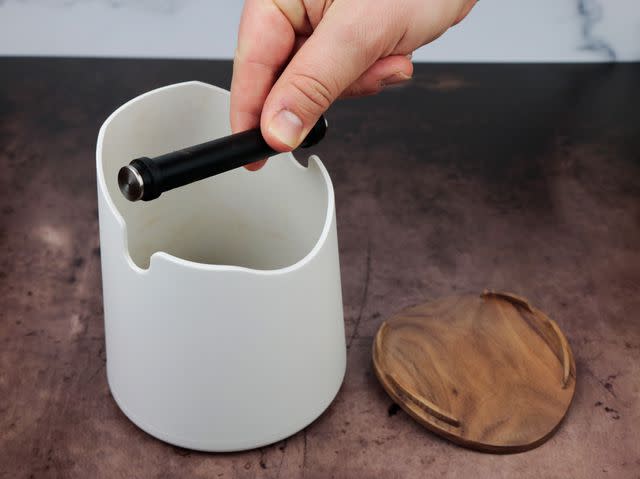
Serious Eats / Jesse Raub
The Crema knock box was much easier to clean with its removable bar.Cleaning out a full knock box was easier when the bar was removable. Coffee grounds can get caught in the crease between the wall of the catchbin and the knock bar itself, and removable bars made this area easier to rinse off (as well as easier to empty the grounds). The Solis, homeffect, and Breville Mini all had removable bars that were easy to pop in and out.
The homeffect knock box was actually the easiest to clean, however, as the entire catchbin in a single plastic surface with no corners or connectors. It was another example of how this unique design outperformed most traditional models.
The Criteria: What to Look for in an Espresso Knock Box
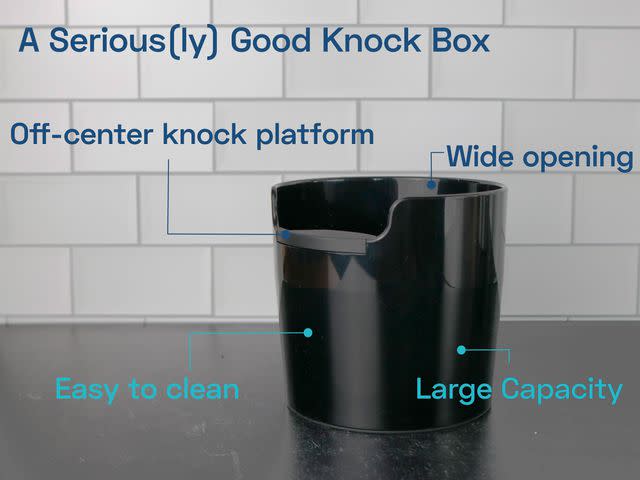
Serious Eats / Jesse Raub
The best knock boxes were comfortable yet sturdy to knock against with an off-center knocking platform. They featured wide openings that caught stray drips and grounds, and had a larger capacity, allowing for multiple espresso shots. They were also easy to clean when the pucks started piling up.
homeffect Knock Box
The Best Espresso Knock Box

What we liked: The knock pad/knock column design on this model is a truly unique approach to knock box design. It allowed for maximum shock absorption, which made it comfortable to knock against while staying firmly rooted to the counter, even with heavy whacks and stuck-in pucks. The fact that the knock platform is also off-center made each popped out puck fall straight into the high-capacity bin below, and its raised sides easily caught any errant drips and loose grounds.
What we didn’t like: The biggest downside is that this knockbox just isn’t that attractive to look at. Knock boxes are part of a home decor, and if you have a specific design taste you’re trying to match, this model might not cut it.
Price at time of publish: $24.
Key Specs
Dimensions: 4.5 x 4 inches
Bar width: 4.5 inches
Weight: 9 ounces
Materials: Plastic, rubber, stainless steel
Care instructions: Dishwasher-safe (hand-washing recommended)
Bonus features: Fits on drip tray, rubber stability base
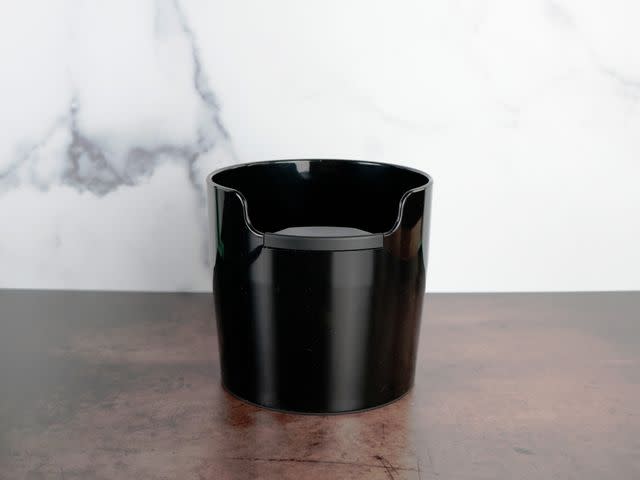
Serious Eats / Jesse Raub
Crema Coffee Products The Arc
The Best-Looking Espresso Knock Box

What we liked: With sleek, modern curves and a walnut lid, this knock box looks nice and performs well. We really liked how the lid hid the splatters and old pucks inside, as well as how it covered up most of the old coffee smell. Its vented edges also let the pucks dry out, preventing mold from growing too quickly. It’s tall enough to hold a lot of coffee, and its removable bar rests on two notches instead of threading through the sides, leaving fewer crevices to be cleaned out.
What we didn’t like: It’s a little pricey and narrow, and the knock bar doesn’t have as much padding as we’d like. That being said, it still performed well on knock tests (with a little concentrated aiming), and if looks are a priority, this knock box has ‘em.
Price at time of publish: $55.
Key Specs
Dimensions: 5 x 5 inches
Bar width: 2 inches
Weight: 7 ounces
Materials: Plastic, rubber
Care instructions: Dishwasher-safe (hand-wash wooden lid)
Bonus features: Knock pad/column, rubber stability base
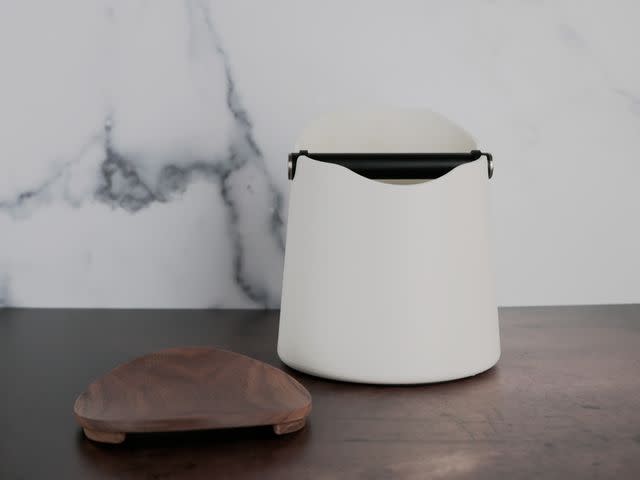
Serious Eats / Jesse Raub
Dreamfarm Grindenstèin
The Best Compact Espresso Knock Box

What we liked: The Grindenstèin was the first product Dreamfarm ever made, debuting 20 years ago in 2003 as one of the first knock boxes designed for home use. And there’s a reason it’s remained popular: it’s squat design and heavy rubber padding on the knock bar make this compact model sturdy and great at shock absorption. It’s a simple design that’s small enough to fit on most drip trays when not in use, making it a great option for people with limited space.
What we didn’t like: Because it’s so compact, the capacity is smaller than our other favorites. It’s also not the prettiest model out there.
Price at time of publish: $25.
Key Specs
Dimensions: 4.5 x 4 inches
Bar width: 4.5 inches
Weight: 9 ounces
Materials: Plastic, rubber, stainless steel
Care instructions: Dishwasher-safe (hand-washing recommended)
Bonus features: Fits on drip tray, rubber stability base
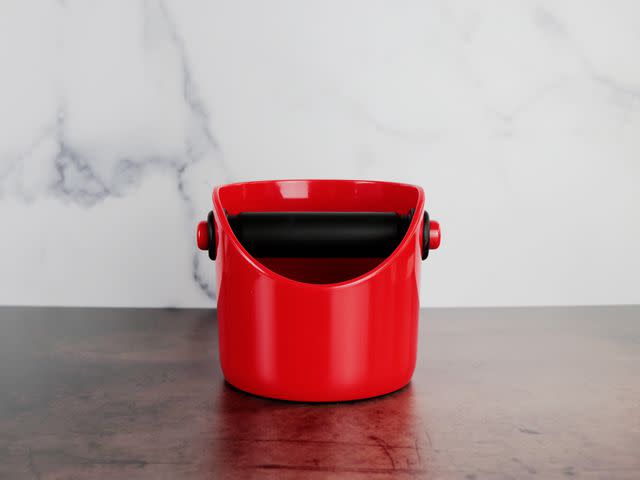
Rattleware Bumper Knock Box
The Best Heavy-Duty Espresso Knock Box

What we liked: The bonus rubber bumper on this knock box added to overall shock absorption and greatly reduced the need for accuracy. The catch bin itself was welded from thick stainless steel, and the sturdy knock bar had a thick rubber coating. Combined with a snug-fitting, solid maple outer box, and you’ve got one heavy-duty piece. This model is a favorite amongst commercial coffee bars and is designed to stand up to heavy use with a high capacity. If you’ve turned your kitchen into a coffee speakeasy for friends who drop by, this might be what you need to keep the line moving fast.
What we didn’t like: It’s a bit large for most counters, and it’s also expensive. People looking to save counter space or a few dollars might be better suited with one of our other picks.
Price at time of publish: $70.
Key Specs
Dimensions: 7.5 x 7 x 4.5 inches
Bar width: 5.5 inches
Weight: 3.5 pounds
Materials: Wood, stainless steel, rubber
Care instructions: Liner is dishwasher-safe, but hand-washing is recommended
Bonus features: Rubber rim, removable liner, rubber feet
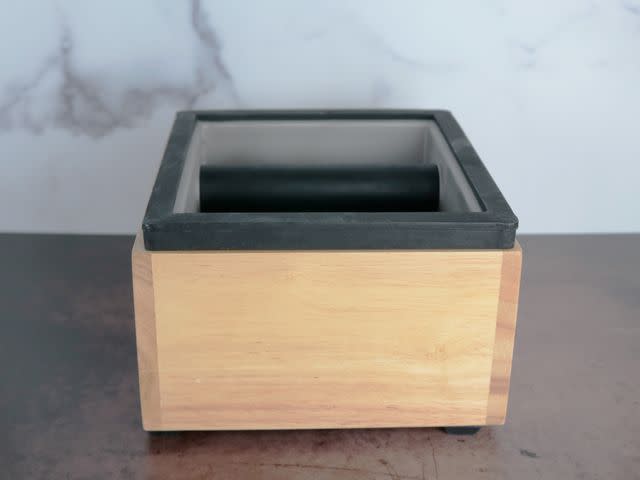
Serious Eats / Jesse Raub
Dibsta Knock Box Drawer
The Best Espresso Knock Box, If You Have The Space

What we liked: The Dibasta Knock Box Drawer is designed as a space saver by sitting underneath a grinder: the top is big and sturdy enough to support the weight of a commercial espresso grinder, and the knock bar lives in high-capacity drawer that can hold at least 50 pucks, if not more. We liked how attractive the wood handle accent was, and the removable bar inside had a very thick coating for great shock absorption and comfort. The other detail we really liked was the slits in the roof: stray espresso grounds are notorious for finding there way on the counter in front of a grinder, but with this knock drawer you could simply sweep them into the slits.
What we didn’t like: It’s expensive, and it's big: the drawer added height to each grinder, making it difficult to fit under kitchen cabinets. And at 12 inches, it was also too long to fit on a separate coffee cabinet.
Price at time of publish: $80.
Key Specs
Dimensions: 12.4 x 8.14 x 2.55 inches
Bar width: 8 inches
Weight: 6.5 pounds
Materials: Stainless steel, plastic, rubber, wood
Care instructions: Hand-wash only
Bonus features: Drawer-style storage, high-capacity bin, grinder platform, slots for brushing grounds into
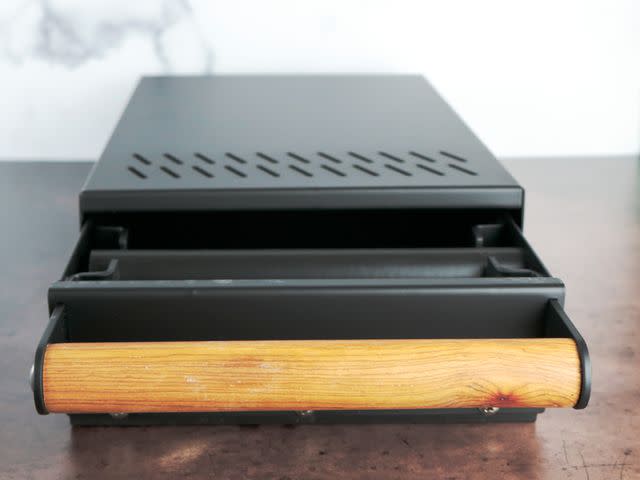
Serious Eats / Jesse Raub
The Competition
Breville Knock Box Mini: This model was small and didn’t have enough padding: every knock sent it bouncing up off the counter.
Breville Knock Box: This model was way too big and didn’t have enough padding: every knock sent a shockwave to our wrist.
Kynano Knock Box: With an ill-fitting outer box, the catch bin wobbled around with each knock, making it uncomfortable to use.
Solis Perfetta Knock Box: Too narrow, and too many crevices: even with a removable bar and removable liner, coffee grounds made their way between the layers, requiring more cleanup.
Saint Anthony Industries The Bloc: While we liked the tamper caddy and the knock column, the catch bin was too flimsy and buckled under pressure. It also was the lowest capacity out of any knock box and required emptying after just two espresso pucks.
FAQs
What is a knock box used for?
A knock box is used for removing spent espresso pucks from the portafilter basket. Because espresso shots are pulled at nine bars of pressure (around 500 pounds of direct force), the spent pucks often become attached to the inside of the espresso basket and need a good solid whack to shake them free. The knock box has a padded surface to knock against and a catch bin to collect the spent pucks.
Why do you need a coffee knock box?
A coffee knock box is great for two reasons: it allows you to swiftly clear out your espresso portafilter basket so you can pull your next shot quicker, and it collects your coffee grounds separate from your regular trash. Because coffee grounds are compostable, many people collect their espresso pucks for their backyard gardens or municipal composting.
When should you clean your knock box?
Coffee grounds—even dried out pucks—still have a fair amount of moisture and are susceptible to mold growth. You should remove old pucks from your knock box every few days, and after emptying the grounds, fully clean your knock box to prevent any coffee residue from growing mold.
Are espresso grounds compostable?
Coffee grounds can add nitrogen to a compost mix, but they need to be fully composted with other food scraps in order for their benefit to be fully realized. If you want to avoid tossing grounds into the trash, check if there's a local composting service that will collect and treat them for you.
Read More:The Breville Barista Express Impress Makes Home Espresso Approachable

